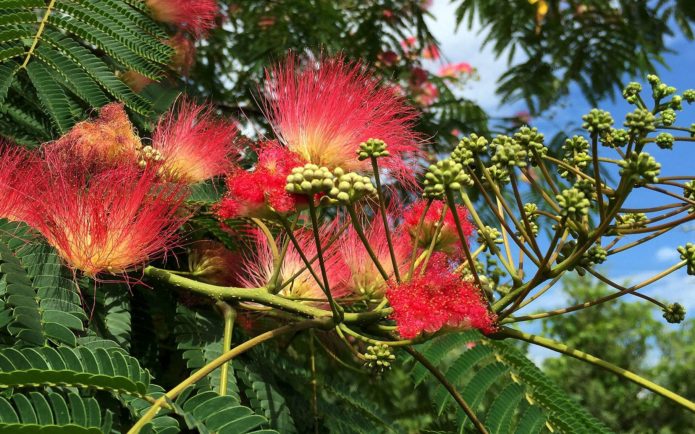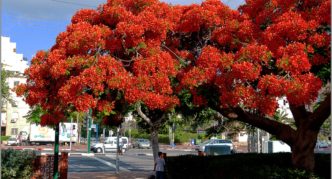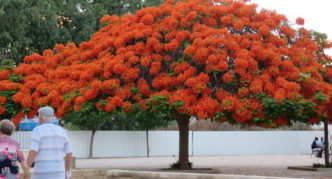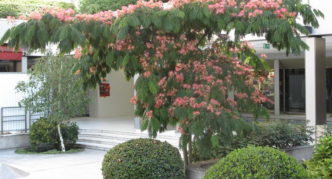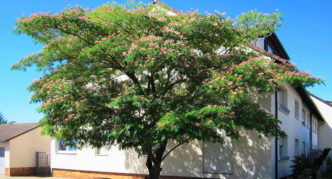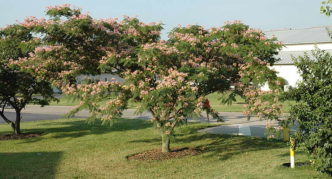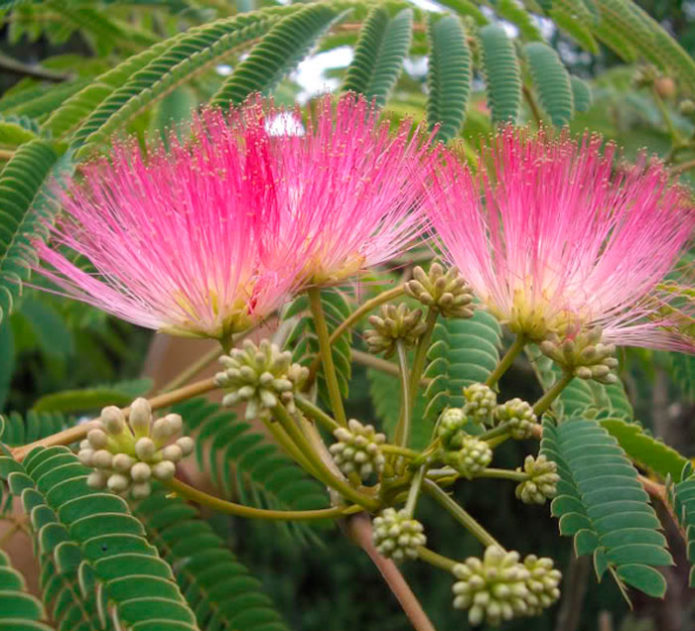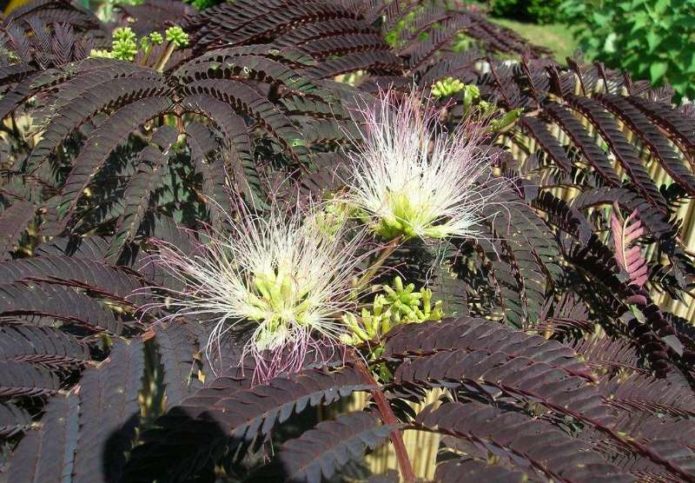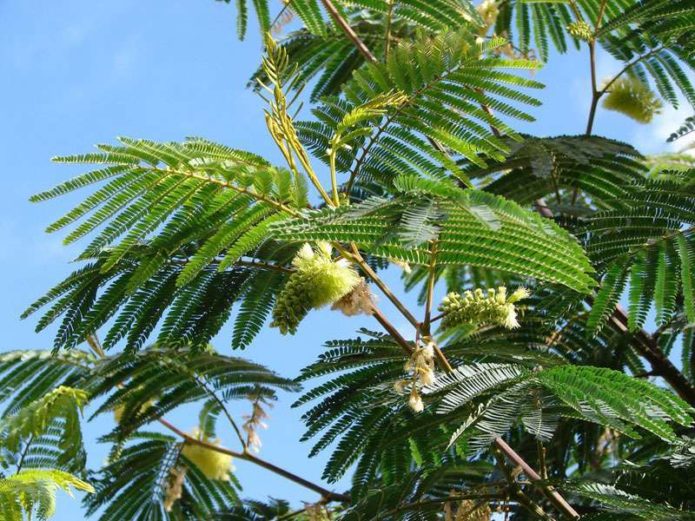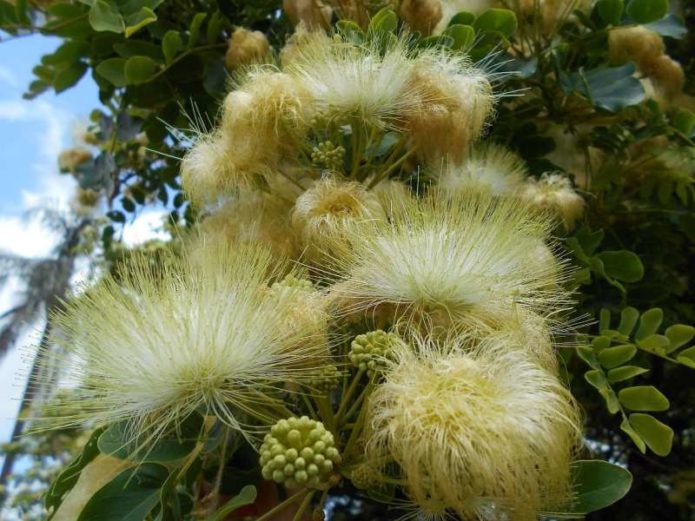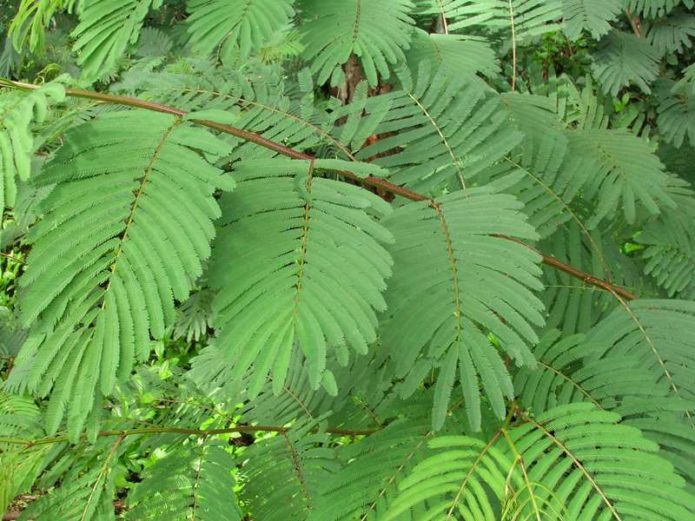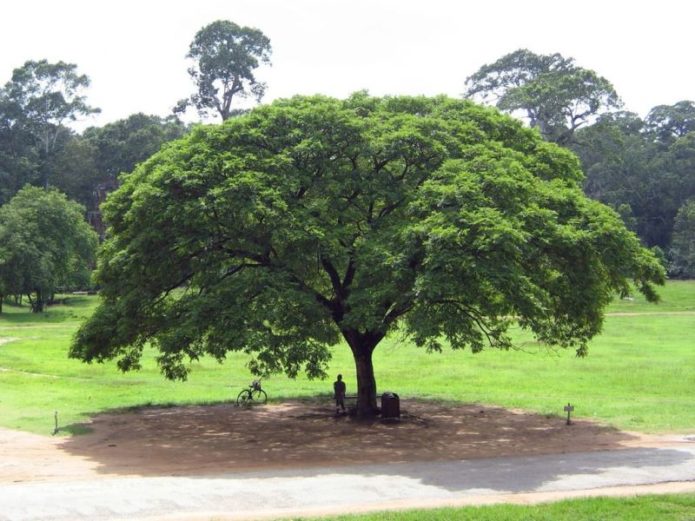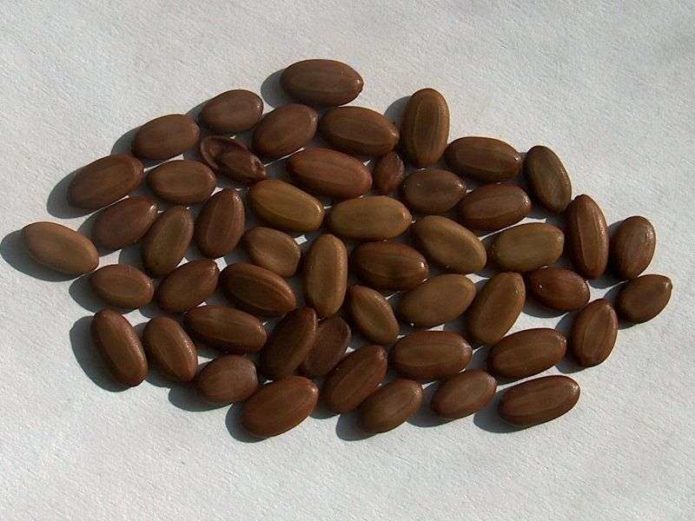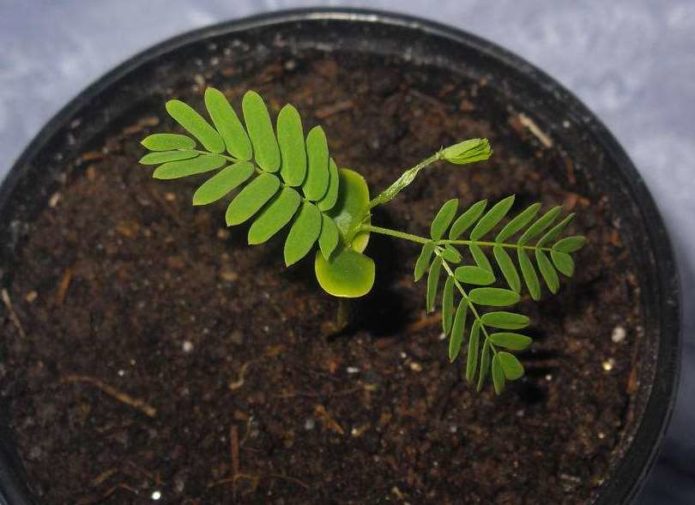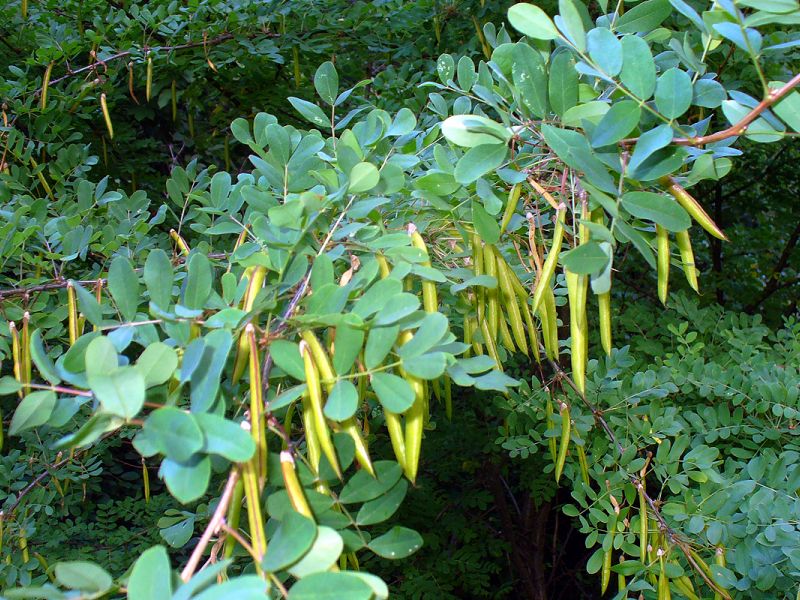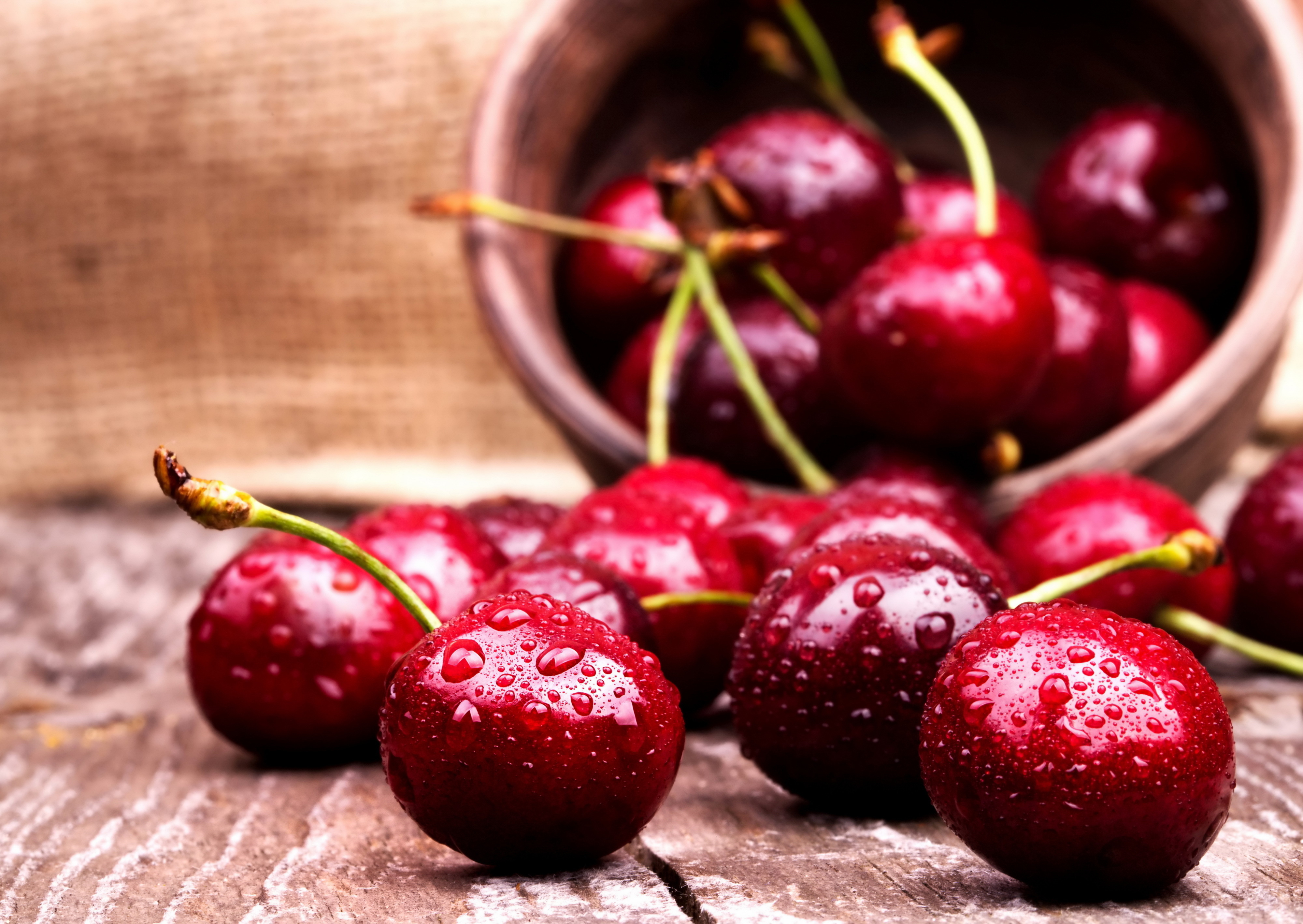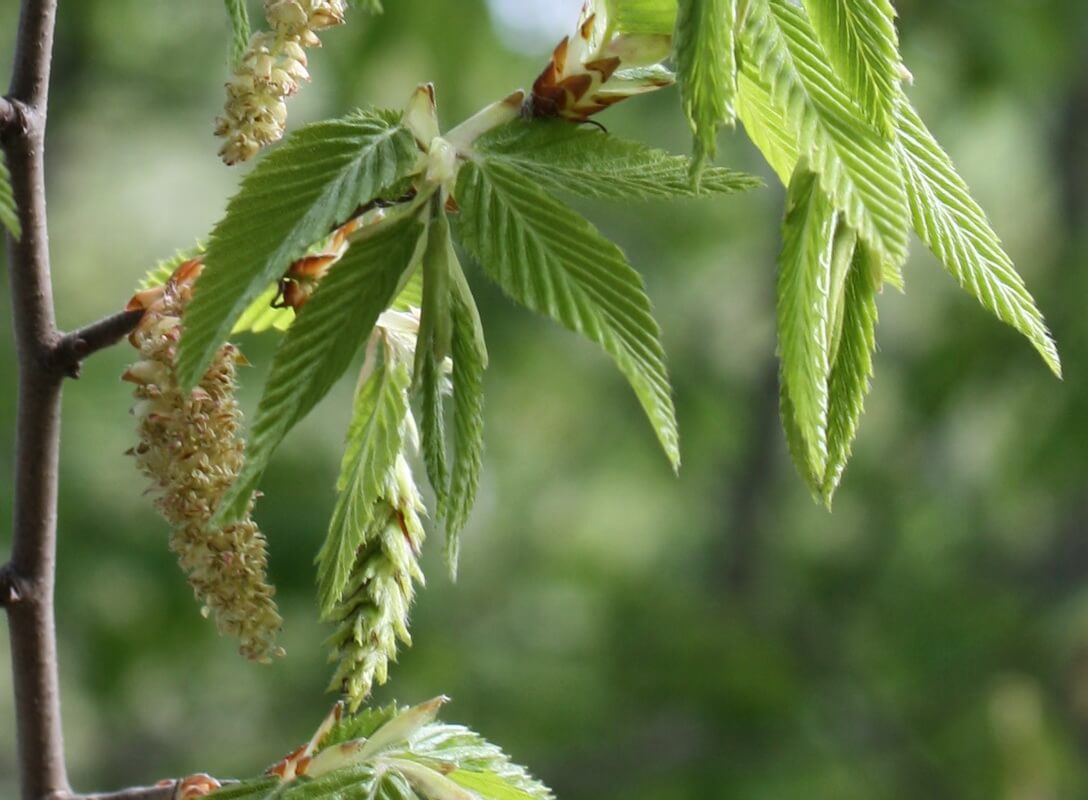Lankaran acacia, also called albicia, is a tall deciduous tree from the legume family. It amazes with its gigantic size and unique silky inflorescences that exude a honey aroma. In its beauty during flowering, it can only be compared with sakura.
Content
Features of growing a plant
Lankaran, or silk acacia - the most catchy variety of the entire genus Albizia due to its spectacular flowering. It is also called mimosa for a similar predisposition to foliage foliage in the dark. It is a thermophilic plant, as it comes from the tropics. Therefore, in our country albicia is grown in the open field only in the south, mainly in the Crimea, Krasnodar Territory, Georgia, Armenia and Ukraine. It belongs to the decorative representatives intended for open spaces. It is decorated not only with private gardens, but also with parks, squares and streets of megalopolises.
Depending on the growing conditions, albition can be a tree or shrub.... The trees grow up to 15 m tall and with a spreading crown 6–7 m in diameter. A lot of space is vitally important for such an acacia, so you will not find it in greenhouses and other enclosed spaces. The second variety includes breeding forms of more compact dimensions, which retained decorative indicators from the "parent". They are cultivated at home.
When breeding Lankaran acacia indoors, one factor should be taken into account - during flowering it forms toxic pollen, which can cause allergic reactions in others.
Albizia reaches its peak of decorativeness during flowering, which falls in mid-summer and lasts until autumn. At this time, the entire crown of trees is completely covered with white-pink paniculate inflorescences. When growing Lankaran acacia, a number of its features should be taken into account:
- low frost resistance - temperatures below -13 ° C can destroy the plant;
- increased light-requiring - prefers bright light and cannot stand shading from nearby trees;
- moisture-loving, but firmly tolerates a short drought;
- the root system is well developed, but vulnerable due to its superficial location;
- loves warmth - the optimal summer temperature is from +26 to 28 ° C;
- not particularly picky about the soil, but grows better in sandy loam and fertile;
- does not suffer from salt spray if landed next to the sea;
- smoke and gas resistant;
- calmly tolerates pruning.
In the regions of central Russia and the North, albition is grown exclusively at home or in greenhouses, since this tropical beauty will not tolerate a harsh winter in the open field.
Video: description of the Lankaran acacia
Role in landscape design and examples in the photo
These spectacular giants look harmoniously both alone on a personal plot, and in combination with other vegetation in city alleys and parks. In addition to its aesthetic function, wood can also be beneficial. Its powerful barrel is ideal for attaching a summer cottage swing. And the luxurious spreading crown will serve as a cover for a gazebo, dining table or sitting area. The aroma emanating from albicia contributes to the creation of a comfortable and romantic atmosphere. It is unlikely that it will be possible to hide from the midday heat under the shade of silky acacia, since the delicate foliage does not hold the sun flux well.
Light-loving plants can be planted under albicia due to the through crown. If you plant seedlings of Lankaran acacia along garden paths or city alleys, then at least five years later, a green tunnel will form, since the foliage is closed by a dome.
- Albizia in bloom
- Miracle tree that will not leave anyone indifferent
- The tree decorating the front door
- Albizia near the house
- Lankaran acacia along the railway tracks
- Silk albitsia in the city square
Popular species and varieties of albicia with photos
The genus Albizia includes over 130 species, but only a limited number of them are cultivated. Common varieties:
- Silk albicia is a deciduous tree up to 15 m high. It has an even trunk up to 30 cm thick and a spreading crown, consisting of large-scale cirrus leaves 19–20 cm long. Outside, leaf plates are deep green, from the inside they are cast white. The tree is often confused with mimosa because of the same silky long stamens. Inflorescences are capitate or spike-shaped. After flowering, flat beans with seeds inside are formed on the plant.
- Summer Chocolate is a subspecies of Lankaran acacia with unusual leaves of a dark brown tone.
- Albitsia Lofanta, or bunch-flowered, is a representative of the shrub type up to 6 m high. It blooms in July with dense oblong yellow inflorescences. They are grouped in several pieces. The plant is native to Western and Northern Australia, and we have successfully taken root only in the Caucasus.
- Albizia Lebecca is the tallest specimen of all species (up to 30 m) with a trunk about 1 m thick.In nature, it grows in India, Burma and the Adaman Islands. Local residents use this tree for medicinal purposes.
- Albizia Sickle - became famous all over the world because of its rapid growth (daily growth is 3 cm). These trees are actively grown in Indonesia, which is due to industrial use - souvenirs are made from the bark.
- Albizia Saman is a tall variety that can grow up to 25 m in height with a crown diameter of 40–45 m. Its distribution area is Central and South America, Southeast Asia. This variety has red or cream-colored flowers.
Planting albicia seeds: step by step instructions
In the open field, albition is propagated by cuttings, and the seeds are first germinated at home. The favorable period for growing seedlings is the end of February - mid-July. For sowing, containers are prepared, which are disinfected with a manganese solution. The soil is bought in the flower department or mixed independently from turf, peat and sand in a ratio of 3: 2: 1. Then it is calcined in an oven at 50-60 ° C for 20 minutes.
To accelerate germination, the seeds of silk acacia are pre-soaked in hot water for 6–7 hours. When they swell, you can sow.
Further sequence of actions:
- At the bottom of the container, a drainage layer 7–10 cm thick is poured. Expanded clay, brick chips or small pebbles are suitable.
- The seeds are pressed into the ground to a depth of 3 mm.
- Water with any growth stimulant.
- Cover with glass or foil to create a greenhouse effect.
Seedlings are placed in a bright and warm place where the temperature does not drop below +23 ° C. It is important to protect the seedlings from the midday heat by creating a light shade. Further care involves daily moistening and opening the protection to ventilate and remove condensation that accumulates inside. With a lack of lighting, phytolamps are installed for illumination.
As soon as the first two true leaves appear on the hatching plants, they start picking in separate pots with a diameter of up to 8 cm. The seedlings are moved to the garden in the spring, when the recurrent night frosts pass. Choose a sunny area and without drafts. Bushes are planted at a distance of 2 m from each other. When burying a seedling, the root collar is left open.
During the first year of growth in a new place, the tree is extended by 20-25 cm in height. During this period, there is no need for top dressing, since the fragile root system can be burned. And also nitrogen in the composition of mineral fertilizers inhibits the hardening of the bark and the plant may not survive its first wintering.
Landing video
Caring for a tree in the garden
Exotic acacia is unpretentious in care, but this does not exclude the observance of elementary agrotechnical measures. With comfortable growth conditions and appropriate care, it will delight its owners for more than a dozen years.
Watering and mulching
Throughout the growing season, albition is often watered, preventing the top soil layer from completely drying out. Water is used settled. The plant should not be heavily flooded, which leads to root rot... After each watering, the soil in the near-stem space is loosened and weeds are removed. Since albicia prefers loose soil and in order to avoid compaction, it is not advisable to walk often near plantings.
You can improve the structure of the soil by mulching with humus, mowed grass or peat. In addition, such a protective layer prevents the rapid evaporation of moisture and inhibits intensive weed growth. It is enough to resort to this procedure once in the spring.
Top dressing
They begin to feed albition from the second year of life. Fertilizers are applied from spring to the end of the growing season. There should be three of them in total:
- Shortly before bud break. Use any fertilizer containing nitrogen (for example, ammonium nitrate) in dosages according to the instructions. Spread the product around the bush at a distance of half a meter from the base and lightly press it into the ground. After the rain, it will wash out and be absorbed by the roots.
- During the formation of peduncles. They choose complex mineral compositions (nitroammofoska, potassium humate, Kemira Lux). The optimal dosage is 3 tbsp. l. for 1 sq. m. landings.
- After flowering. Potassium-phosphorus preparations (superphosphate, potassium sulfate) are introduced, which will help prepare the plant for winter. 2-3 tbsp will be enough. l. powder per 1 sq. m planted area. It is scattered and covered with a layer of humus about 10 cm from above.
Pruning
Albitsia must be periodically pruned, not only to give the tree a decorative look, but also to slow down its growth. This is done in early spring before bud formation begins. The crown is thinned out by cutting off excess shoots, as well as frost-damaged, weakened and dry branches. In this way, it is also possible to protect the plant from diseases, since in the damaged areas there is a high risk of developing pathogenic microflora.
Do not worry if the tree is very frozen. Albitsia tends to quickly recover and build up green mass.
Wintering
Adult Lankaran acacia can withstand temperatures as low as -16 ° C.But young plantings, which are not yet a year old, are especially sensitive to frost and may die. Therefore, it is recommended to prepare them in advance. For protection, sheets of cardboard or foam rubber are used, which are folded into a pipe and put on a tree. The root space is insulated with natural means: peat, humus, fallen leaves and other plant waste from the garden. The soil is covered with polyethylene.
On adult trees, the shoots are cut to half and the root collar is spud. Any non-woven material is thrown on top, fixing it on the sides with stones.
Table: problems encountered in growing albicia and ways to solve them
| Painful manifestations | Causes | Correction methods |
| Shedding leaves | Over or under watering | Normalize the irrigation regime |
| The appearance of brown spots on the leaf plates, curling of the leaves around the edges | Soil composition issues or tree placement in a draft | Transplant the plant to a new location |
| Underdevelopment of buds and their premature fall | Lack of moisture | Water more often |
| Loss of saturated color leaves | Lack of light or nutrients in the soil | Change the location of the albition, additionally make additional feeding |
Reproduction
Silk acacia reproduces without problems by self-seeding. Mature trees can be propagated by cuttings or cuttings.
Root processes
The method involves separating the root growth and planting it separately. No preliminary soil preparation is required. The procedure is carried out after flowering is complete.
Cuttings
For cuttings, woody shoots and leafy last year's branches are chosen. Delenki about 20 cm long are cut from them. Each must have at least 2-3 living buds. Before planting, the cut is treated with a growth stimulant and the existing leaves are cut off by a third. Rooting occurs in 2.5–3 months.
Green cuttings are harvested in the middle of the summer season, lignified ones - in the spring.
Albizia is a spectacularly flowering tree that can transform any garden and fill it with an unforgettable scent. It attracts not only people, but also bees, since it is a honey plant. Subject to the basic rules of care, this exotic beauty is not difficult to grow in the open field of our climate. The lifespan of street albicia is from 50 to 70 years, and of indoor albition is not much less.
